Evolutionary Algorithms: Transform Business With AI Optimization

Is your business ready to optimize solutions and boost efficiency? In today’s complex data landscape, evolutionary algorithms offer a powerful approach for companies to quickly and effectively identify optimal strategies. MOR Software provides an in-depth overview in this article to help businesses understand how these algorithms can enhance performance and streamline operations.
What Are Evolutionary Algorithms?
Evolutionary algorithms are a family of optimization and search methods inspired by natural selection. Instead of directly calculating the single best answer through a fixed formula, an evolutionary algorithm starts with a population of many candidate solutions (often called individuals).

During each generation, the evolution algorithm follows a repeated cycle:
- Evaluate each solution’s quality using a fitness function.
- Select the best-performing individuals to survive.
- Crossover (recombine) them to produce new solutions by exchanging information.
- Mutate some individuals to introduce AI diversity and avoid premature convergence.
Core Concepts Of Evolutionary Algorithms
Evolutionary algorithms are built on a set of core principles that enable them to perform effectively in solving complex optimization problems. Below are four fundamental concepts that any evolutionary algorithm applies in its operation.
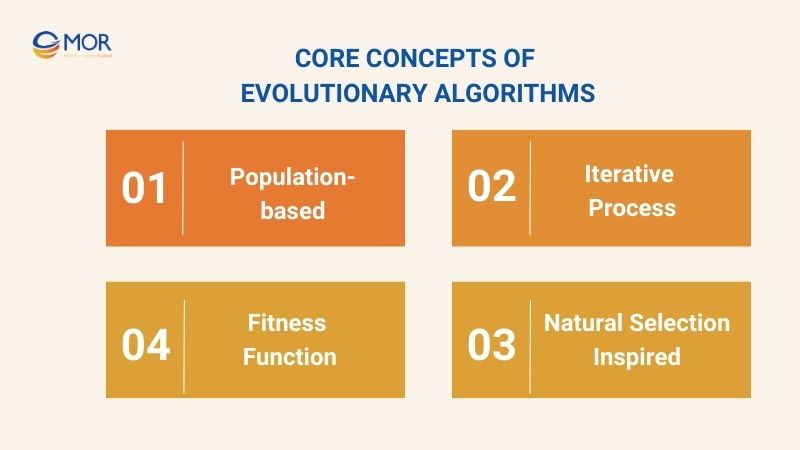
Population-based
One of the most important features of evolutionary algorithms is the population-based approach. This means the algorithm always maintains a population of multiple candidate solutions instead of working with a single solution at a time.
Each individual in the population represents a possible way to solve the problem and is evaluated using a fitness function.
Example – Delivery Route Optimization:
Goal: Deliver packages to 50 locations with the shortest total distance.
- Step 1 – Initialize population: Create 200 individuals, each with a different delivery order.
- Step 2 – Evaluate: Calculate the total distance for each individual to determine fitness.
- Step 3 – Selection: Keep the best-performing routes.
- Step 4 – Crossover: Combine two good routes to form new ones.
- Step 5 – Mutation: Randomly swap two delivery points to explore new possibilities.
Over several generations, the population evolves toward better solutions, increasing the likelihood of finding the optimal delivery plan.
Iterative Process
An evolutionary algorithm operates through a repeated cycle over many generations to gradually improve solution quality.
Unlike methods that aim to find the answer in a single step, an evolution algorithm works in cycles. It repeats evaluation, selection, crossover, and mutation until it reaches the target or the maximum number of generations.
Example – Product Design Optimization:
Goal: Find the most efficient fan blade shape to reduce noise and increase airflow.
Process:
- Initialize 100 different blade designs.
- Evaluate each design’s performance (fitness).
- Select the top 20 designs.
- Apply crossover and mutation to create new designs.
- Repeat until the desired performance is achieved.
Natural Selection Inspired
Evolutionary algorithms are directly inspired by natural selection, where stronger individuals are more likely to survive and pass their traits to the next generation. In the machine learning algorithms, this means only solutions with high fitness are selected for reproduction.
A genetic algorithm, a popular type of evolutionary algorithm, follows this principle. It combines strong solutions to create new ones and removes weaker solutions.
Fitness Function
In AI evolutionary algorithms, the fitness function acts as the measurement tool to evaluate how good each solution is. Every individual is scored based on the problem’s objectives, and this score determines its chances of being selected for the next generation.
For evolutionary algorithms to be effective, the fitness function must accurately reflect the optimization goal. A poorly designed function can cause the algorithm to evolve in the wrong direction.
Benefits Of Evolutionary Algorithms For Your Business
The use of evolutionary algorithms offers technical advantages and delivers clear value for businesses across multiple industries. The following sections explore their most important benefits, including their role in developing intelligent AI evolutionary algorithms.
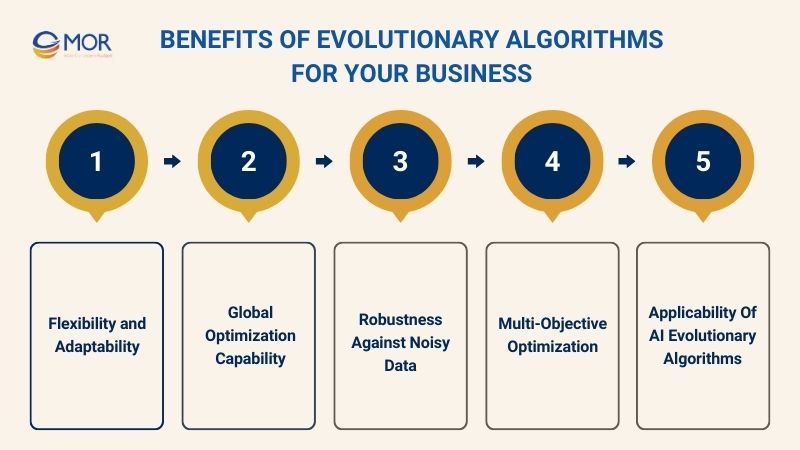
Flexibility and Adaptability
One of the standout advantages of evolutionary algorithms is their high flexibility and adaptability to various types of data and environments. Unlike traditional algorithms that require standardized data, they can handle numerical, image, text, and even mixed datasets.
According to an ACM review, evolutionary algorithms perform effectively even when real-world data is inaccurate, noisy, discrete, or complex, thanks to their general-purpose and stochastic search methods.
Global Optimization Capability
An evolutionary algorithm can search for global optimum solutions instead of getting stuck in local optima. This is particularly crucial for problems with vast, complex search spaces that contain many local traps.
For example, in transportation network design, the algorithm can optimize the entire system to reduce congestion and improve efficiency.
Robustness Against Noisy Data
In reality, input data is rarely perfect; it may be incomplete, biased, or noisy. Evolutionary algorithms are valued for maintaining performance even when data is imperfect or contains noise.
For instance, in weather forecasting, sensor-collected data may have errors or delays. By maintaining a diverse population of solutions, the algorithm can still identify reliable forecasting models and reduce the negative impact of low-quality data.
Multi-Objective Optimization
Many real-world optimization problems involve multiple, often conflicting objectives. AI evolutionary algorithms can generate solutions that balance multiple objectives at once.
For example, in electric vehicle design, one objective might be to increase driving range, while another is to reduce production cost. The algorithm will generate multiple design options, each offering a different trade-off between these two goals.
Applicability Of AI Evolutionary Algorithms
AI evolutionary algorithms play an important role in AI development services. They can optimize model architectures, fine-tune hyperparameters, and even automatically generate new learning strategies.
A ScienceDirect survey shows that evolutionary algorithms optimize neural network architectures and fine-tune hyperparameters. They can also generate new learning strategies, highlighting their key role in intelligent AI development.
Popular Types Of Evolutionary Algorithms
In the field of optimization, several popular evolutionary algorithms are widely used due to their ability to solve complex problems. Below are three representative types.
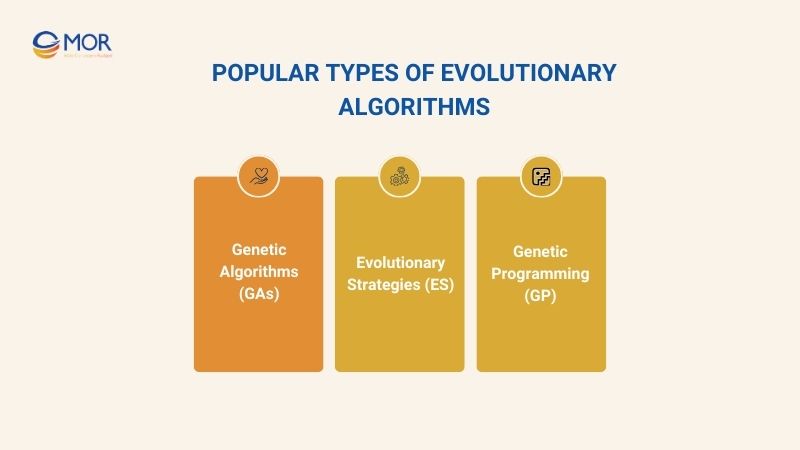
Genetic Algorithms (GAs)
Genetic Algorithms (GAs) are a popular type of evolutionary algorithm, mimicking natural selection to optimize numerical solutions or parameters. GAs work by:
- Initializing a population of feasible solutions
- Evaluating each solution using a fitness function
- Selecting the best solutions (selection)
- Combining solutions (crossover) and applying small variations (mutation) to create a new generation
Example: A drone manufacturing company wants to optimize weight and durability. GAs will:
- Generate multiple design variants (population-based)
- Evaluate them based on weight and durability (fitness function)
- Combine the best designs (crossover)
- Apply minor adjustments (mutation)
After several generations, the algorithm finds the optimal design that balances lightness and durability.
Evolutionary Strategies (ES)
Evolutionary Strategies (ES) focus on optimizing continuous parameters and often use real-valued mutation rather than discrete variations. ES excels in continuous, complex optimization problems thanks to the dynamic adjustment of step size for faster convergence.
Example: In robotics, a company wants to optimize a robot’s movement for maximum speed while maintaining stability. ES will:
- Initialize multiple movement configurations (population-based)
- Evaluate speed and stability (fitness function)
- Adjust movement parameters (mutation)
- Select the best configurations (selection)
After several generations, ES identifies the optimal parameters enabling the robot to move both fast and stably.
Genetic Programming (GP)
Genetic Programming (GP) is a type of evolutionary algorithm where solutions are represented as programs or formulas, rather than numeric parameters. GP is ideal for automatically developing AI as a service or optimizing expressions in complex, hard-to-model problems.
Example: A financial company wants to generate a formula to predict stock prices. GP will:
- Initialize multiple prediction programs (population-based)
- Evaluate each program’s accuracy (fitness function)
- Combine top programs (crossover) and create new variations (mutation)
After several generations, GP discovers the optimal prediction program, improving stock price forecasting accuracy.
How Do Evolutionary Algorithms Work?
In evolutionary algorithms, the search for an optimal solution takes place through multiple iterative steps. This approach allows the algorithm to maintain population diversity and handle noisy or incomplete real-world data.
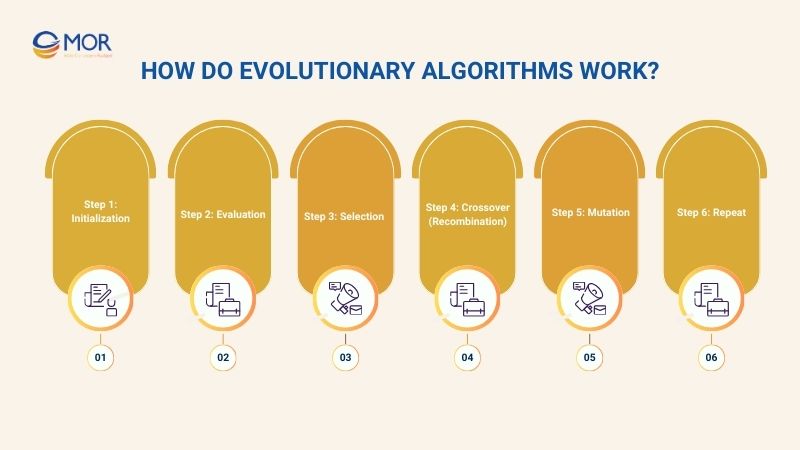
Step 1: Initialization
The first step in evolutionary algorithms is initialization. The algorithm generates an initial population of candidate solutions, often randomly, within the search space. This ensures population diversity, allowing the algorithm to explore multiple directions and increasing the chances of finding the optimal solution.
Step 2: Evaluation
Once the population is created, each individual is assessed using a fitness function to measure the quality of the solution. This evaluation identifies the best-performing solutions and provides the basis for selection and generating the next generation.
Step 3: Selection
Based on the fitness results, the algorithm performs selection of the top individuals to create the next generation. This ensures that the genetic information of strong solutions is preserved while weaker solutions are eliminated, guiding the population toward the optimal solution.
Step 4: Crossover (Recombination)
In this step, individuals are combined to produce offspring, exchanging genetic information between them. Crossover generates new solutions that may outperform their parents and maintains population diversity.
Step 5: Mutation
Mutation introduces small changes to the population, creating new variations. This step preserves diversity, prevents the population from getting trapped in local optima, and increases the likelihood of discovering the global optimal solution.
Step 6: Repeat
The steps of evaluation – selection – crossover – mutation are repeated until the stopping criteria are met or the optimal solution is found. This iterative process is the core of evolutionary algorithms, gradually improving solution quality across generations.
>>> READ MORE: Custom AI Solutions: Why They’re a Smart Investment (+ 9 Uses)
Applications Of Evolutionary Algorithms In Real Life
In real life, evolutionary algorithms are widely applied due to their ability to solve complex problems. Here are some key real-world applications:
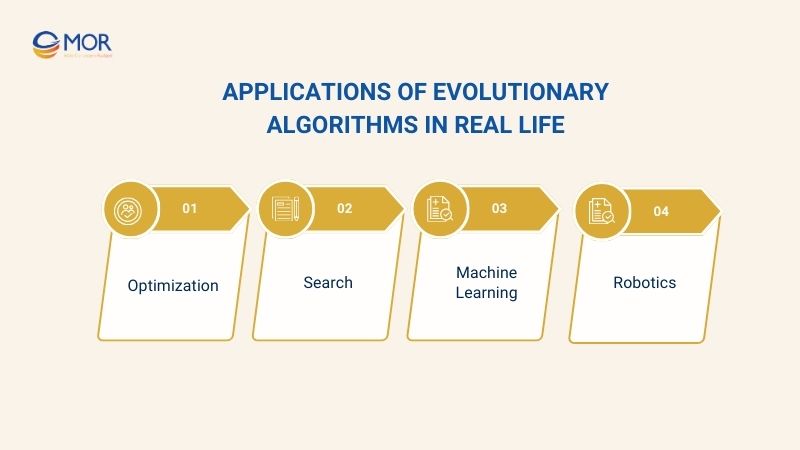
Optimization
One of the most important applications of evolutionary algorithms is optimizing complex, multidimensional functions with multiple local optima. Unlike traditional algorithms, EAs use a population of solutions and repeatedly evaluate, select, recombine, and mutate them to find the global optimum.
Example: An energy company wants to arrange solar panels on rooftops to maximize electricity generation. The algorithm will:
- Initialization (population-based): Generate multiple arrangements of solar panels
- Evaluation (fitness function): Calculate the electricity output of each arrangement
- Selection & Crossover: Combine the best arrangements to create new configurations
- Mutation: After several iterations, the algorithm proposes the optimal layout, increasing energy production and reducing installation costs.
Search
Evolutionary algorithms are highly effective for searching for solutions in large and complex spaces. They perform well even when traditional methods struggle or face numerous constraints.
Example: A logistics company needs to optimize delivery routes for hundreds of trucks and delivery points:
- Initialization: Generate multiple route plans for the entire fleet
- Evaluation: Calculate total delivery time, cost, and fleet usage for each plan
- Selection & Crossover: Combine the most efficient routes to produce new plans
- Mutation: After multiple iterations, EA identifies the optimal delivery routes, minimizing time and cost while meeting all delivery requirements.
Machine Learning
Evolutionary algorithms play a key role in machine learning. These algorithms optimize model parameters, enhance training efficiency, and automatically design neural network architectures to improve prediction accuracy.
Example: A fintech company wants to develop a credit risk prediction model:
- Initialization: Generate multiple model configurations with different hyperparameters
- Evaluation: Measure the accuracy and risk classification of each model
- Selection & Crossover: Combine the best-performing models to create improved versions
- Mutation: The result is an optimized machine learning model, enhancing prediction accuracy and reducing misclassification risks.
Robotics
Evolutionary algorithms are used to improve control algorithms and autonomous planning in robotics, particularly in complex or uncertain environments.
Example: Researchers want to optimize the movement of a cleaning robot in a factory:
- Initialization: Generate multiple movement strategies for the robot
- Evaluation: Measure task completion time, amount of waste collected, and energy consumption
- Selection & Crossover: Combine the most efficient strategies to create new plans
- Mutation: After several iterations, the robot achieves optimal performance, moving faster, collecting more efficiently, and using less energy.
In Conclusion
Don’t miss the opportunity to upgrade your business processes with the power of evolutionary algorithms. Discover how these intelligent algorithms can optimize solutions, enhance performance, and provide a competitive edge. Contact MOR Software today to start applying this advanced technology to your business.
MOR SOFTWARE
Frequently Asked Questions (FAQs)
What are evolutionary algorithms used for?
Evolutionary algorithms are used for solving complex optimization and search problems where traditional methods fail.
What is a key characteristic of evolutionary algorithms?
Evolutionary algorithms are characterized by population-based search and iterative improvement through selection, mutation, and recombination.
What is the primary objective of the evolutionary algorithm?
The primary objective of an evolutionary algorithm is to find optimal or near-optimal solutions to complex problems.
What are the components of an evolutionary algorithm?
Components of an evolutionary algorithm:
- Population initialization
- Fitness evaluation
- Selection mechanism
- Genetic operators (crossover, mutation)
- Replacement strategy
How do we prevent premature convergence in EP?
Prevent premature convergence by maintaining diversity through mutation, niching, or adaptive selection strategies.
Rate this article
0
over 5.0 based on 0 reviews
Your rating on this news:
Name
*Email
*Write your comment
*Send your comment
1